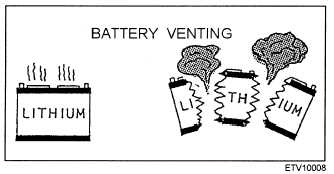Environmental and Natural Resources
Program Manual, (OPNAVINST 5090.1), for
more disposal information on lithium batteries.
If you use lithium batteries on a daily basis, we
recommend that you get a copy of the Technical Manual
for Batteries, Navy Lithium Safety Program
Responsibilities and Procedures, NAVSEA S9310-
AQ-SAF-010, and read through it.
Lead-Acid Cell Batteries
This is the most widely used wet-cell battery. It is
also one of the most dangerous batteries to use and
maintain. Lead-acid batteries use sulfuric acid, and their
battery gases (mainly hydrogen) are extremely
explosive. You’ll see this battery in automobiles and
large backup power systems.
Remember, lead-acid batteries are very dangerous.
To prevent injury to yourself, you should use the
following safety precautions:
1 .
2 .
3 .
4.
5.
6 .
Always keep open flames and sparks of all
kinds away from lead-acid batteries.
Be sure to have proper ventilation when you
charge lead-acid batteries to prevent the build-
up of hydrogen gas.
Follow the manufacturer’s instructions when
charging lead-acid batteries.
Handle battery acid (electrolyte) V E RY
carefully. This material is highly corrosive to
the skin and eyes and requires full body
protection.
Keep the battery acid above the tops of the
separators.
Use only pure, distilled water when adding
liquid to lead-acid batteries.
7 .
8 .
9 .
10.
11.
Do Not operate lead-acid batteries in
temperatures over 125 degrees Fahrenheit (52
degrees Celsius).
Do Not connect or disconnect charging
connections when charging current is flowing.
Do Not short-circuit lead-acid battery
terminals.
Do Not pour water into battery acid; always
pour the acid into the water. And, make sure
you wear appropriate skin and eye protection
whenever you handle battery acid.
Do Not put or allow salt water into a lead-acid
battery. It will create an extremely toxic
chlorine gas.
Nickel-Cadmium Cell Batteries
Commonly known as NICADs, nickel-cadmium
batteries are used in most cordless, rechargeable
equipment, such as flashlights, cordless drills, and
soldering irons, and in portable stereos.
The following safety precautions for NICADs are
relatively simple:
1 .
2 .
3 .
4 .
5 .
6 .
Charge NICADs in series, never in parallel.
Always follow the manufacturer’s instructions
for charging NICADs.
Do Not expose NICADs to temperatures over
113 degrees Fahrenheit (45 degrees Celsius).
Do Not short-circuit NICADs.
Do Not store NICADs and lead-acid batteries in
the same container or in the same area.
Do Not dispose of NICADs by throwing them
overboard. Temporarily store exhausted cells in
a steel container until you can dispose of them
properly ashore.
VACUUM TUBES
There are basically two categories of vacuum tubes:
(1) electron tubes, and (2) cathode-ray tubes. There are
certain safety precautions you need to follow when
working with or handling vacuum tubes. The following
paragraphs provide a brief discussion on the safety
precautions for each category of tube.
2-7


